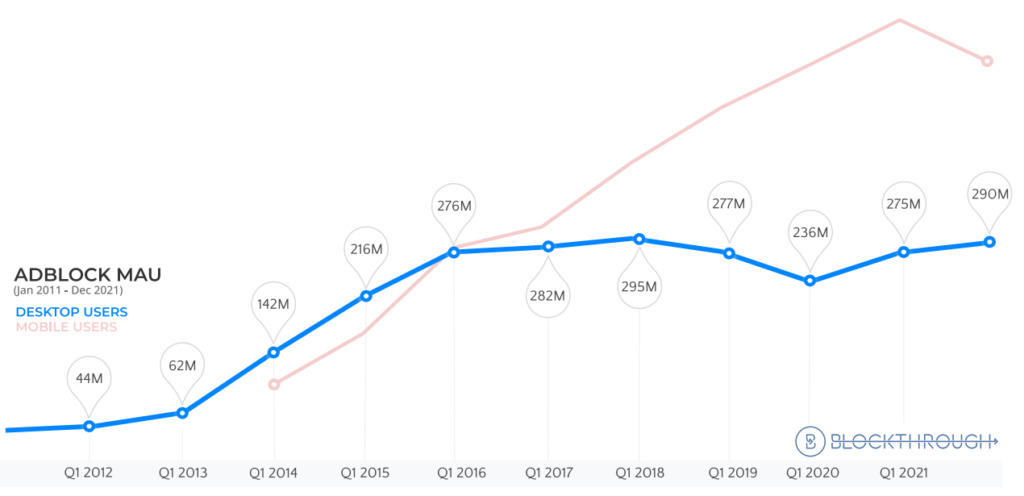The increase of adblocking on the desktop began to slow in 2016, reaching its peak in 2018, before beginning to fall through 2020. However, over the last two years adblocking has started to rise again, with 290 million web users actively blocking ads worldwide in 2021.

Takeaways
- The 2022 PageFair Adblock report, produced by adblocking revenue-recovery company Blockthrough, highlights the return to growth in adblocking among web users on the desktop. With revenue from advertising on the mobile web still relatively low, the report suggests this is a trend reversal publishers should monitor closely.
- The change in 2021 adblocking numbers comes with a decline in the adoption of adblock walls as a revenue recovery strategy. Leading US publishers gave up on adblock walls or messaging as a strategy to counter the problem; only one of the top 100 US publishers was relying exclusively on an adblock wall according to the report.
- Blockthrough focused this year’s report – its eighth – on usage of adblock walls, running a UX study to test how users reacted when encountering an adblock wall. With around 80% of users seeing adblock walls as an intrusion, publishers’ shift away from adblock walls seems to be in line with user preferences.
Adblock wall intrusions
- Marty Krátký-Katz, Co-founder & CEO, Blockthrough notes that adblockers typically don’t convert when encountering an adblock wall. Instead they just get annoyed at the intrusion and head off to find alternative content sources.
- Users install adblockers to avoid interruptions and Krátký-Katz thinks publishers need to bypass the sales pitches used by adblock wall vendors and listen to what users want. He says, at the most basic level, the pop-up messages triggered by adblock walls are an interruption to the browsing experience:
As a solution, adblock walls perpetuate the very problem that they intend to solve.
Preferred solutions
- Moving on from the ‘all-or-nothing approach that adblockers started out with, most blockers now allow non-invasive ads to be served to users that have opted-in to see ads that comply with the Acceptable Ads standards set by the Acceptable Ads Committee.
- Acceptable Ads excludes ad formats that are considered overly intrusive, described as a lighter ad experience, and considered “acceptable” by at least 65% of the adblock users surveyed. In giving web users control over the online advertising experience, ad-filtering tools are said to return to a ‘fair value exchange’ between users and publishers.
- The report finds Acceptable Ads’ opt-in rates reaching 95% among ad block users for the first time. With 216 million ad blockers using browsers and extensions that support Acceptable ads, the user base has grown by 50% since the beginning of 2019. According to the report, users opted-in to the Acceptable Ad standard are:
-
- 50% more likely to post comments in forums
-
- 76% more likely to post a product/service review
-
- 26% more likely to engage with brands
Publisher actions
The 2022 Pagefair report highlights the fact that 94% of the publishers surveyed globally can’t say precisely what revenue they are losing to adblocking.
More than 60% of the top 100 US publishers use at least one adblock monetization strategy to recover lost income. Almost all support Acceptable Ads, finding it the ‘most reliable and sustainable means to monetize their ad-blocking and ad-filtering audience’.
However, 32% of the publishers surveyed are not doing anything about adblocking and less than 30% have an adblock recovery strategy in place, according to Blockthrough.
The report highlights the fact that it is difficult for publishers to prioritize the revenue recovery until they are aware of the scale of the full scale of the problem.
Publishers’ openness to evaluating recovery strategies grows in proportion to their confidence level in adblock rate measurement.










